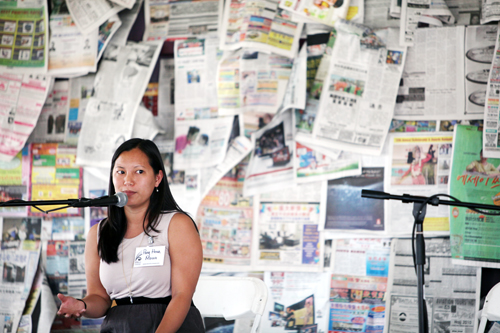Talkstory: Southeast Asians Go Back “Home”

Against a backdrop of multilingual newspapers and magazines, Pang Houa Moua recalls the story of her Hmong family, how they tried to cross the border to a refugee camp in Thailand from Laos after the Vietnam War. And the fateful decision for her grandparents to stay in Laos and her father’s decision to go.

Now a Hmong American, Pang Houa Moua works with the Southeast Asia Resource Action Center as Director of Communications to assist and obtain educational access for Southeast Asian American communities, foster civic engagement, and further the cause of their representation on a national level.
Speaking on the second day of the Smithsonian Folklife Festival, Pang Houa Moua and Saw Sandi Tun, Director of the Burmese American Collective, discussed the topic of transnationalism and about the ties and motivations that foster international relationships among Southeast Asian Americans and perhaps their desire to go “home.”
“It’s a nostalgia for a place that doesn’t exist anymore,” Pang Houa Moua says.
Political, social, and cultural developments in Southeast Asian countries have changed the landscape entirely. What some Southeast Asian Americans remember as “home” is a place that exists only in memory.
Pang Houa Moua grew up in the U.S. It wasn’t until she was in her twenties that she even met her grandparents who stayed in Southeast Asia.
For her, and for the younger generations of Southeast Asian Americans, the American way of life is the one they grew up with and, for some, the only one they’ve known. Many of those who do visit their family’s ancestral homes find that they do not fit in. This is a big issue for perfectly legal immigrants and permanent residents who are sometimes deported for minor offenses when they apply for U.S. citizenship. They are ordered to “return” to a country that sometimes they never even knew or had set foot in.
And sometimes, they are not even welcomed “back.”

Political changes in Burma in the 1960s and military rule have complicated the return of those who left the country.
“Once you leave Burma, you cannot go back,” says Saw Sandi Tun.
But whether they can or will or want to “return” or not, there are global ties that link Southeast Asian American communities to Southeast Asia, may it be a memory of a place or an evolving way of life that is as Southeast Asian as it is American.
For more Talkstory panels, visit the Smithsonian Folklife Festival on the National Mall.


Discussion